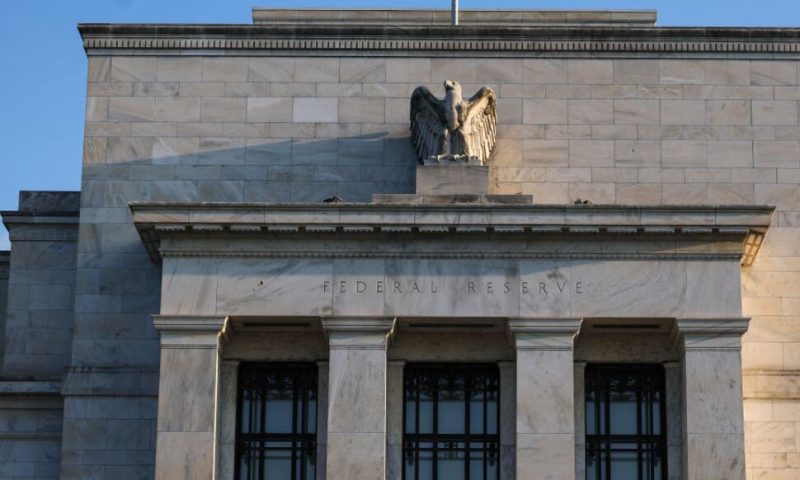There will also be several key reports on the health of the labor market.
The Federal Reserve meets on Tuesday for two days to consider raising interest rates, with most analysts predicting its fourth three-quarters of a point increase as it tackles the highest inflation in four decades.
The personal consumption expenditures price index last week confirmed core inflation, stripping out energy and food costs, advanced by 0.5% in September, unchanged from August. The annual increase of 5.1% remains way above the Fed’s goal of a 2% average level.
That means the central bank will stay the course with its aggressive tightening of monetary policy. But there are signs that its anti-inflation stance – reversing years of cheap and easy money – is having an effect, and so the focus on Wednesday when Chairman Jerome Powell holds a press conference will be on what the Fed does next.
Suggestions that the Fed might take a pause, or lower the amount it raises rates in December, has led the stock market to post impressive gains in recent days, capped off by an 828-point gain for the Dow Jones Industrial Average on Friday.
“Ultimately, we feel the Fed will likely begin to reduce the size of increases and then pause to assess their cumulative effect, but we expect the narrative will remain “higher for longer” rather than than entertaining any kind of ‘pivot’ language,” David Norris, partner and head of U.S credit at TwentyFour Asset Management, wrote on Friday.
Already, some sectors of the economy are flashing yellow, if not red. Housing has been hit particularly hard, with pending home sales down 10.2% in September and 31% year over year. Rents, meanwhile, fell 0.8% nationally last month, according to data from apartment rental firm Zumper.
“Yes the rental market is cooling rapidly, even seasonally adjusted,” Julia Coronado, president and founder of MacroPolicy Perspectives, tweeted on Saturday. “Even a return to pre-pandemic rates of housing inflation would subtract at least a percent off core inflation – a huge step in the right direction, and this is happening WITHOUT A RECESSION, what is happening?”
And while rents and house prices take a while to show up in the monthly consumer price index, the Fed will be well aware of the shifting landscape in the rental housing market, where an abundance of new construction is coming to market at a time the economy is slowing.
“The reversal of fortune in the multifamily market has come fast and deep,” CoStar Group, owner of Apartments.com, noted last month. “While year over year rent growth data presents a highly positive snapshot, pulling back the curtains reveals a market where the majority of rents are retreating quickly.”
“Additionally, while Sunbelt markets continue to boast record new unit deliveries this year, the meager positive absorption totals registered year to date taper the impact,” it added. “Vacancy rates are expected to rise further in the fourth quarter, pushing rent growth even lower.
Another critical component of government inflation data is wage growth and there, as with housing, the picture is changing for the better.
“After a rapid ascent over the past 18 months, wages and compensation are starting to slow down,” Nick Bunker, research director at online job site Indeed, wrote on Friday. “The pace of growth is still robust, but wages are no longer running at the torrid pace we’ve recently seen.”
Bunker says that private sector wages grew at an annual rate of 4.8% in the third quarter, down from 6.5% in the prior quarter. The number of available positions open for hiring fell by more than 1 million last month.
While the spotlight will be on the Fed this week, it is also “jobs week” for economic data with the job openings number for October released on Tuesday, followed on Wednesday by private payroll firm ADP’s monthly jobs survey and then on Friday the monthly nonfarm payrolls report from the Labor Department.
Much of the economy’s immediate future will rest on the shoulders of the American consumer, responsible for nearly 70% of economic activity. So far, the consumer has proven resilient even in the face of inflation running at an 8.2% annual clip. But a cushion of savings built up during the coronavirus pandemic, credit cards and higher wages have helped consumers manage.
“Real disposable income – income after taxes and adjusted for price changes – was unchanged in September,” Lydia Boussour, senior economist at EY Parthenon, wrote on Friday. “As consumers feel the squeeze from elevated inflation, they are increasingly relying on their savings to sustain their spending. The personal savings rate fell from 3.4% to 3.1% last month – the lowest rate since April 2008.’’
In essence, the economy is in a tug of war between declining consumer purchasing power and the Fed’s battle against inflation. Will consumers or the Fed blink first?
“Inflation is still high, but goods price increases are slowing, and services inflation will likely slow as well in 2023 as the housing market continues to cool and slower wage growth makes businesses raise prices more slowly,” Bill Adams, chief economist for Comerica Bank, wrote on Friday.
“Higher interest rates and the unwind of the Fed’s asset purchases have slammed the brakes on the housing market, and cooled the rest of the economy as well,” Adams added. “With the overall economy continuing to decelerate, that slowdown in inflation will most likely continue into 2023. If so, the Fed will likely conclude its rate hikes in early 2023.”

